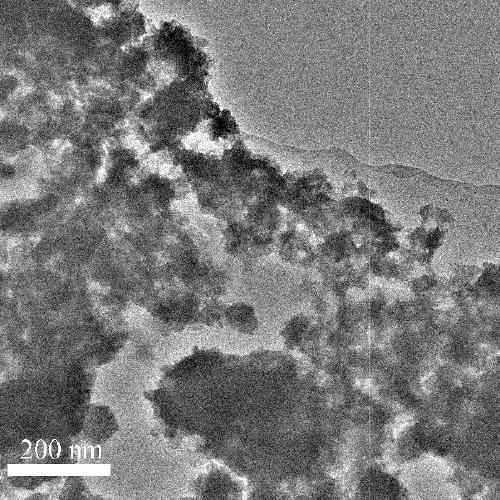Solid-phase method for preparing tin oxide-tin sulfide heterojunction nanoflowers
A solid-phase preparation and tin oxide technology, applied in tin oxide, chemical instruments and methods, nanotechnology, etc., can solve the problems of high energy consumption, harsh experimental conditions, etc., and achieve the effects of simple operation, low cost, and simple synthesis process
- Summary
- Abstract
- Description
- Claims
- Application Information
AI Technical Summary
Problems solved by technology
Method used
Image
Examples
specific Embodiment approach 1
[0015] Specific implementation method 1: Accurately weigh 0.01 mol tin tetrachloride pentahydrate and place it in an agate mortar, grind it thoroughly, add 0.005 mol sodium lauryl sulfate, grind for 60 minutes and mix well, then add 0.002 mol thiosulfate Acetamide, grind for 60 minutes and mix well, then add 0.036 mol sodium hydroxide, then grind it thoroughly for 60 minutes and leave it for 3 hours to ensure that the solid phase reaction is complete. Wash it with deionized water and absolute ethanol, filter it with suction, and dry it in a drying oven at 60°C for 2 hours to obtain a tin oxide-tin sulfide heterojunction.
specific Embodiment approach 2
[0016] Specific embodiment 2: Accurately weigh 0.01 mol tin tetrachloride pentahydrate and place it in an agate mortar, grind it thoroughly, add 0.005 mol sodium lauryl sulfate, grind for 60 minutes and mix well, then add 0.006 mol thiosulfate Acetamide, grind for 60 minutes and mix well, then add 0.028 mol sodium hydroxide, then grind it thoroughly for 60 minutes and leave it for 3 hours to ensure that the solid phase reaction is complete. Wash it with deionized water and absolute ethanol, filter it with suction, and dry it in a drying oven at 60°C for 2 hours to obtain a tin oxide-tin sulfide heterojunction.
specific Embodiment approach 3
[0017] Specific embodiment 3: Accurately weigh 0.01 mol tin tetrachloride pentahydrate and place it in an agate mortar, grind it thoroughly, add 0.005 mol sodium lauryl sulfate, grind for 60 minutes and mix well, then add 0.010 mol thiosulfate Acetamide, grind for 60 minutes and mix well, then add 0.020 mol sodium hydroxide, then grind it thoroughly for 60 minutes and leave it for 3 hours to ensure that the solid phase reaction is complete. Wash it with deionized water and absolute ethanol, filter it with suction, and dry it in a drying oven at 60°C for 2 hours to obtain a tin oxide-tin sulfide heterojunction.
PUM
 Login to View More
Login to View More Abstract
Description
Claims
Application Information
 Login to View More
Login to View More - R&D
- Intellectual Property
- Life Sciences
- Materials
- Tech Scout
- Unparalleled Data Quality
- Higher Quality Content
- 60% Fewer Hallucinations
Browse by: Latest US Patents, China's latest patents, Technical Efficacy Thesaurus, Application Domain, Technology Topic, Popular Technical Reports.
© 2025 PatSnap. All rights reserved.Legal|Privacy policy|Modern Slavery Act Transparency Statement|Sitemap|About US| Contact US: help@patsnap.com

